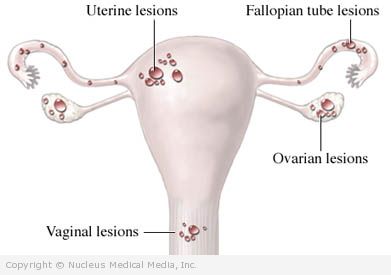Endometriosis – Definition
Normally, endometrial tissue is found only inside the uterus. The uterus is the reproductive organ where a fetus develops. Hormones cause the tissue to form there, preparing the body for a fertilized egg. If you do not become pregnant, the tissue leaves the body during menstruation.
In endometriosis, endometrial-like tissue is found outside the uterus. For example, it may be found on organs in the abdomen or pelvis. In these places, the tissue still responds to hormones. It swells, breaks down, and bleeds. But it is unable to leave when you menstruate. Surrounding tissue becomes inflamed. There is often scarring.

Endometriosis – Causes
Possible causes include:
- Menstrual tissue backs up through the fallopian tubes and spills into the abdomen
- Immune system may allow the tissue to implant on other organ surfaces and develop into endometriosis
- Lymph system may carry endometrial cells from the uterus
- Certain cells on abdominal organs turn into endometrial tissue
Hormones and growth factors cause the disease to progress.
Endometriosis – Risk Factors
A risk factor is something that increases your chance of developing this condition. The following may be associated with endometriosis:
- Family history, a mother or sister with endometriosis
- Early onset of menstruation
- Not having children — Pregnancy slows or stops the disease from progressing. The condition usually resolves at menopause. The symptoms may return with hormone replacement therapy.
- Prolonged menstrual bleeding (more than 7-8 days)
- Abnormal development of the uterus, with a blocked segment
Endometriosis – Symptoms
Symptoms range from mild to severe. You may have many large growths with little pain. Or, you may have small areas with intense pain.
Symptoms include:
- Cramping and pelvic pain (especially just before and during menstrual bleeding)
- Pain during sex ( dyspareunia)
- Heavy periods
- Low back pain
- Pain during bowel movements or urination
- Infertility
- Miscarriage
Endometriosis – Diagnosis
Your doctor will ask about your symptoms and medical history. A pelvic exam will be done. These are best done early in the menstrual period. Since you may not have any symptoms, diagnosis is usually confirmed with a laparoscopy. This test allows the doctor to see if there are patches of endometrial tissue and scar tissue.
Endometriosis – Treatment
The goals of treatment are to:
- Control pain
- Slow endometrial growth
- Restore or preserve fertility
Treatment options depend on:
- Severity of symptoms
- Size, number, and location of growths
- Degree of scarring
- Extent of the disease
- Age and whether you want to have a baby
Treatment includes:
Pain Medication
Your doctor may recommend:
- Over-the-counter pain relievers to ease mild symptoms
- Prescription pain relievers (often needed)
- Nonsteroidal anti-inflammatory drugs to reduce inflammation and help with cramping (best when taken on a regular basis)
Hormonal Therapy
Hormones are an option for women who are not trying to become pregnant. Birth control pills and other injectable drugs interfere with estrogen production. These medicines may decrease pain and shrink the size and number of endometrial growths. But, endometrial growth tends to come back when the hormones are stopped. A common way to take birth control pills is continuously, so that you no longer menstruate. After surgery, birth control pills may reduce the chance of these growths from returning.
Surgery
If you have severe symptoms or you want to get pregnant, doctors can try to remove endometrial growths. This is often done with laparoscopic surgery. In severe, unmanageable cases it may be advised to also remove the uterus and ovaries. But this means that you cannot get pregnant.
If you are diagnosed with endometriosis, follow your doctor’s instructions.
Endometriosis – Prevention
There is no known way to prevent this condition.
